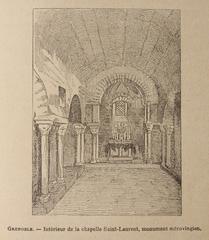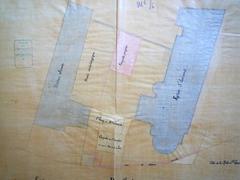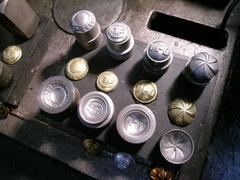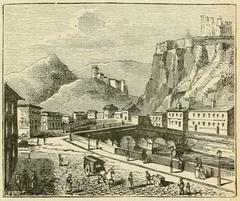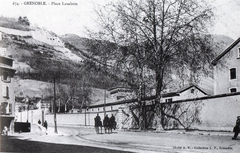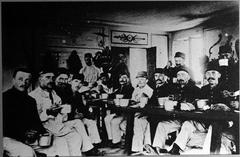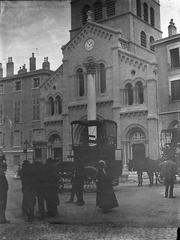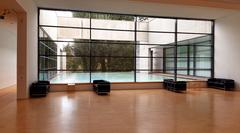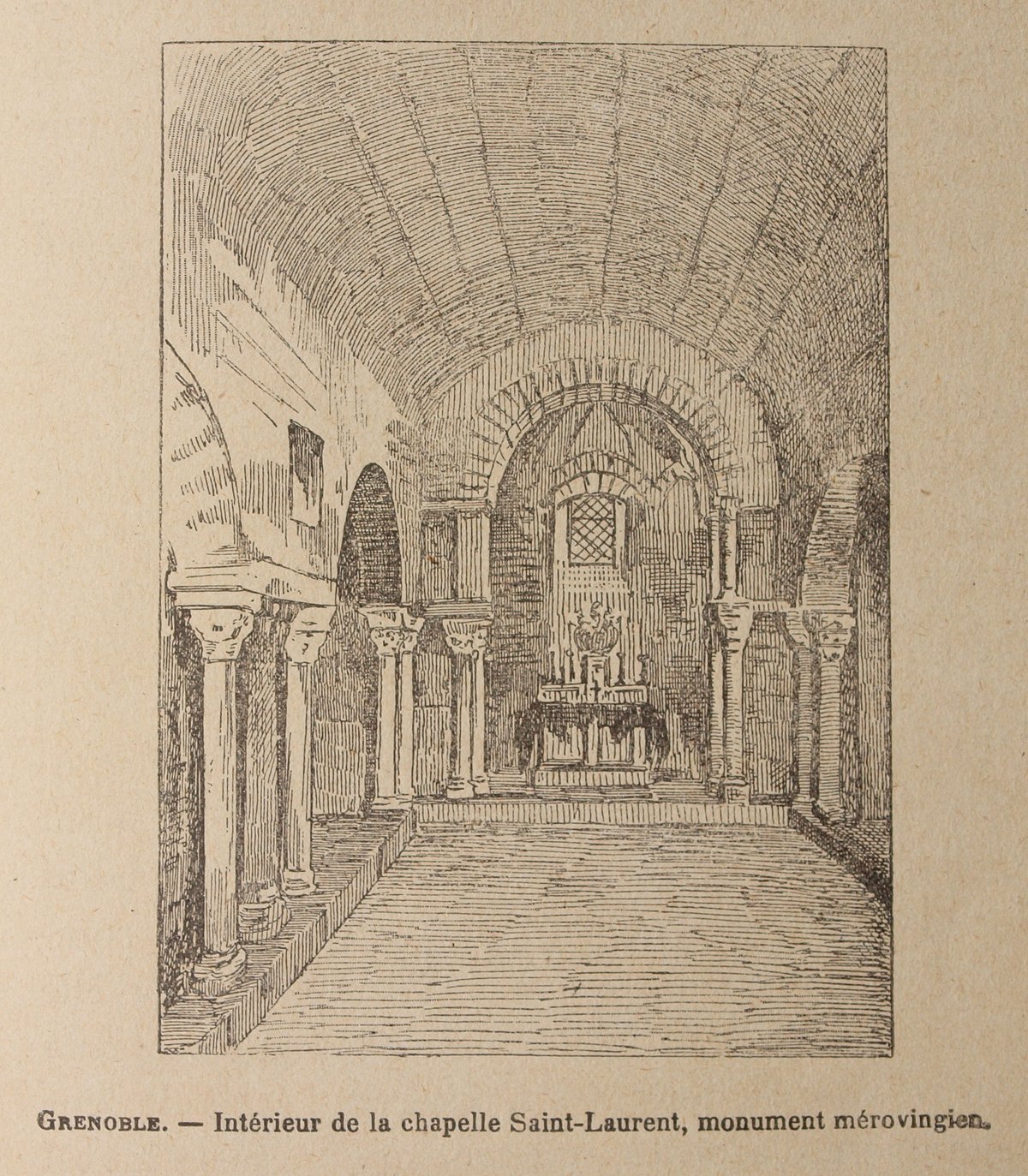
Grenoble Archaeological Museum: Visiting Hours, Tickets, and Guide to Grenoble Historical Sites
Date: 15/06/2025
Introduction
The Grenoble Archaeological Museum (Musée Archéologique Grenoble - Saint-Laurent) stands as a singular testament to Grenoble’s layered past, offering visitors a rare opportunity to journey through nearly two millennia of the city’s history. Situated in the historic Saint-Laurent district, the museum is built upon the remains of a Gallo-Roman necropolis, an early Christian sanctuary, and a medieval church. Its centerpiece, the 6th-century Saint-Oyand crypt, is among the oldest preserved Christian monuments in the region, providing invaluable insight into the evolution of religious architecture and burial practices.
Today, the museum is renowned for its seamless integration of ancient structures, archaeological remains, and contemporary design, exemplifying best practices in conservation and visitor accessibility. With original burials, sarcophagi, and a wealth of artifacts displayed in situ, the site offers an immersive educational experience. The museum’s proximity to other landmarks such as the Musée Dauphinois and the Bastille Fortress makes it a focal point for exploring Grenoble’s historical and cultural landscape.
This guide provides a comprehensive overview of the Grenoble Archaeological Museum—including its historical evolution, architectural features, permanent and temporary exhibitions, visitor facilities, accessibility information, and practical travel tips. For the most current information on hours, tickets, and events, consult the official Grenoble Pass or Grenoble Tourism portals.
Table of Contents
- Introduction
- Historical Evolution
- Architectural Significance
- Permanent Collections and Exhibitions
- Temporary and Collaborative Exhibitions
- Visitor Information
- Travel Tips and Nearby Attractions
- Conservation and Sustainability
- Booking, Reservations, and FAQs
- Conclusion
- References
Historical Evolution
Origins and Early Christian Roots
The museum’s site on the right bank of the Isère River was a significant necropolis by the 4th century CE, serving the early Christian community of Cularo, the Roman predecessor to Grenoble (Grenoble Pass). Extensive excavations between 1978 and 1995 uncovered hundreds of tombs, sarcophagi, and remnants of early Christian worship spaces, most notably the 6th-century Saint-Oyand crypt. This crypt stands as a key monument of early medieval Christianity in southeastern France, revealing the transition from Gallo-Roman traditions to Christian burial and worship practices.
Medieval and Modern Transformations
By the 9th century, a church was established above the crypt, reflecting the growing religious significance of Saint-Laurent. This structure underwent several reconstructions from the Romanesque through the Gothic periods, with distinct architectural layers evident throughout the museum today. The church served the community until the 19th century, after which it was deconsecrated and ultimately transformed into the archaeological museum now open to the public.
Archaeological Discoveries and Conservation
Over 1,500 burials and a wealth of artifacts—including jewelry, coins, and everyday objects—have been uncovered and preserved on site (Getty Publications). The museum’s approach prioritizes in situ preservation, allowing visitors to experience the original context of the site. Modern conservation techniques, such as environmental monitoring and non-invasive stabilization, ensure the site’s long-term preservation (EOLSS).
Architectural Significance
The Saint-Oyand Crypt
At the heart of the museum lies the Saint-Oyand crypt, a rare and well-preserved example of early medieval religious architecture. Characterized by barrel-vaulted chambers, carved stone capitals, and a horseshoe-shaped apse, the crypt reflects the architectural transition from the Roman Empire to the Merovingian period. Its authenticity and preservation make it a highlight of any visit.
Architectural Layers: Romanesque, Gothic, and Modern
Above the crypt, visitors can trace the evolution of ecclesiastical architecture, from Romanesque arches and medieval wall paintings to later Gothic vaults. Thoughtful modern interventions—such as glass walkways and subtle lighting—enhance the visitor experience while respecting the site’s historical integrity.
Urban Context
Located at 2 Place Saint-Laurent, the museum sits within a vibrant historic neighborhood, surrounded by medieval streets and key landmarks like the Musée Dauphinois and Bastille Fortress (facts.net). Its central position makes it an ideal starting point for exploring Grenoble’s broader historical context.
Permanent Collections and Exhibitions
Archaeological Remains and Site Features
The museum’s permanent collection is inseparable from its archaeological context. Over 1,500 burials spanning the 4th to 18th centuries—including early Christian sarcophagi and medieval tombs—are preserved and displayed in situ. Visitors can walk above these remains on glass walkways, gaining a unique perspective on Grenoble’s ancient and medieval past (Grenoble Tourism).
Artifacts and Objects
The collection includes:
- Gallo-Roman pottery and glassware: Everyday items reflecting Roman material culture.
- Jewelry and grave goods: Rings, brooches, and personal effects illustrating social customs.
- Coins: Spanning from the Roman Empire through the Middle Ages, tracing economic shifts.
- Liturgical objects: Chalices, crosses, and reliquaries highlighting Christian traditions.
- Stone inscriptions and funerary stelae: Carved with Latin and early Christian texts.
Interpretive and Multimedia Displays
Interactive digital panels, 3D reconstructions, touchscreens, and augmented reality enrich the visitor experience, offering archaeological, historical, and religious context. Multilingual audio guides encourage a chronological exploration of the site (Grenoble Tourism).
Temporary and Collaborative Exhibitions
The museum hosts regular temporary exhibitions on themes such as funerary practices, early Christian art, and archaeological science. Collaborative events with local institutions, including the Musée Dauphinois and Musée de Grenoble, contribute to diverse and dynamic programming. The museum also participates in city-wide initiatives like European Heritage Days and the Night of Museums (Grenoble Tourism).
Visitor Information
Visiting Hours and Admission
- Open: Tuesday to Sunday, 10:00 AM – 6:00 PM
- Closed: Mondays and select public holidays
- Admission: Free for all visitors (Trip.com), although special exhibitions or group tours may require advance booking (Auvergne Rhône-Alpes Tourisme).
Location, Access, and Directions
- Address: 2 Place Saint-Laurent, 38000 Grenoble, France
- Public Transport: Tram B (Notre Dame-Musée stop), Bus 16 (Saint-Laurent stop)
- Parking: Limited; public transport is recommended (Grenoble Tourisme).
Facilities and Accessibility
- Wheelchair accessible: Ramps, elevators, and accessible restrooms available
- Audioguides: Free, in French, English, Spanish, and Italian
- Signage: Multilingual, with interpretive panels throughout the site
- Restrooms and cloakroom: Onsite
- Gift shop: Books, postcards, and souvenirs
- Wi-Fi: May be available; check at the information desk
Guided Tours and Educational Programs
Guided tours are offered regularly, led by archaeologists and historians. Educational workshops and interactive activities engage families and school groups. Advance booking is recommended for groups and educational visits (Grenoble Tourisme).
Visitor Experience and Highlights
Walking atop glass walkways, visitors experience the museum’s archaeological layers firsthand, from the 6th-century crypt to the medieval church remains. Artifacts are displayed where they were found, enhancing the authenticity of the visit. The tranquil atmosphere, natural light, and integration of modern and ancient elements create a contemplative and visually stunning environment (The Crazy Tourist, Wikipedia).
Travel Tips and Nearby Attractions
- Best time to visit: Weekday mornings, particularly in June (Wanderlog)
- Visit duration: 1.5–2 hours recommended
- Photography: Non-flash photography allowed; restrictions may apply to certain exhibits
- Language: French and English signage; audioguides in several languages
- Family-friendly: Activities, booklets, and scavenger hunts available (Lodgis Blog)
- Nearby sites: Musée dauphinois, Old Bishop’s Palace Museum, Bastille fortress (all within walking distance)
- Food and drink: No café onsite; numerous dining options nearby
Conservation and Sustainability
The museum employs elevated walkways and glass barriers to protect the archaeological site, and uses climate control and environmental monitoring to preserve artifacts. It supports ongoing research and public education, exemplifying sustainable cultural preservation (Wikipedia, EOLSS).
Booking, Reservations, and FAQs
- Individual visitors: No reservation required
- Groups: Advance booking recommended for tours and educational programs (Auvergne Rhône-Alpes Tourisme)
- Special events: Some exhibitions or workshops may require tickets; see the official website for details
Frequently Asked Questions
Q: What are the museum’s opening hours?
A: Tuesday to Sunday, 10:00 AM–6:00 PM; closed Mondays and select holidays.
Q: Is the museum wheelchair accessible?
A: Yes, with ramps, elevators, and accessible facilities.
Q: Is admission free?
A: Yes, admission is free for all visitors.
Q: Are guided tours available?
A: Yes, in several languages; group tours require advance booking.
Q: Can I take photographs?
A: Non-flash photography is permitted; check for restrictions on certain artifacts.
Q: What are the nearby attractions?
A: Musée dauphinois, Old Bishop’s Palace Museum, Bastille fortress.
Conclusion
The Grenoble Archaeological Museum is an unmissable destination for anyone interested in Grenoble’s layered history and cultural heritage. As a model site museum, it seamlessly blends archaeological preservation, architectural history, and visitor engagement. Its free admission, central location, and accessibility make it a highlight for local residents and travelers alike. Enhance your visit with guided tours, family activities, and the Audiala app, and take time to explore the wealth of historical sites nearby.
For the latest information on visiting hours, exhibitions, and special events, consult the following resources:
References
- Grenoble Archaeological Museum: Visiting Hours, Tickets, and Historical Insights, 2024, Grenoble Pass (Grenoble Pass)
- Grenoble Archaeological Museum: Visiting Hours, Tickets, and Historical Highlights, 2024, Grenoble Tourism (Grenoble Tourism)
- Visiting the Grenoble Archaeological Museum: Hours, Tickets, and Essential Visitor Information, 2024, Auvergne Rhône-Alpes Tourisme (Auvergne Rhône-Alpes Tourisme)
- Grenoble Archaeological Museum: A Complete Visitor’s Guide to History, Heritage, and Practical Information, 2024, SWTLiving (SWTLiving)
- Grenoble Archaeological Museum: A Complete Visitor’s Guide to History, Heritage, and Practical Information, 2024, Travel2Next (Travel2Next)
- Conservation and Site Preservation, 2024, EOLSS (EOLSS)
- Grenoble Archaeological Museum Historical Overview, 2024, WhichMuseum (WhichMuseum)
